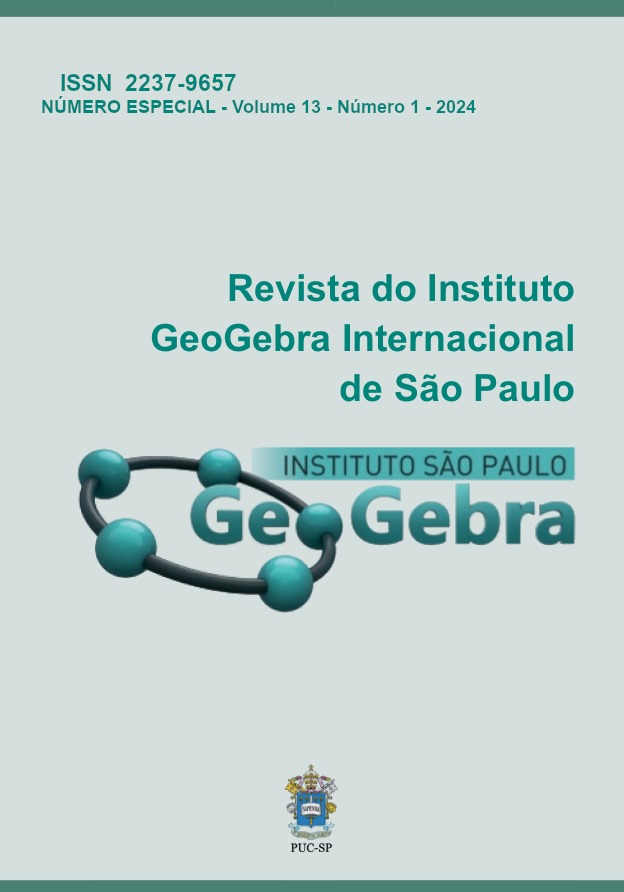Estudo Completo das Funções Seno e Cosseno com o Apoio do Software GeoGebra
DOI:
https://doi.org/10.23925/2237-9657.2024.v13i1p196-217Palavras-chave:
GeoGebra & STEAM, Funções seno e cosseno, Aprendizagem SignificativaResumo
A presença das tecnologias nas mais variadas camadas da sociedade vem impondo novos modelos metodológicos do processo de ensino e aprendizagem e mudanças na concepção de diversos processos educativos. O presente artigo resulta de um estudo de caso descritivo-interpretativo e avaliativo, essencialmente qualitativo, com objetivo de compreender como o software GeoGebra pode contribuir no estudo completo das funções trigonométricas seno e cosseno a partir da análise gráfica, baseado na realização de tarefas, desenvolvidas em uma turma de 50 alunos da 11ª Classe na Escola Secundária da Munhuana localizada na cidade de Maputo. Este estudo se enquadra no âmbito do projeto de investigação do pós-doutoramento subordinada ao tema “GeoGebra e STEAM: implicações para a melhoria da Educação Matemática e das Ciências Naturais em Moçambique”. Os principais resultados ressaltam a autonomia e o maior envolvimento dos alunos na resolução de tarefas, maior interação aluno-software, apropriação dos conteúdos, construção de modelos e manipulação de parâmetros.
Palavras-Chave: GeoGebra & STEAM; Funções seno e cosseno; Aprendizagem Significativa.
Referências
ARTIGUE, M. Épistémologie et Didactique. Recherches en Didactique des Mathématiques, Paris, v. 10, n. 23, p. 241-286, 1990.
FERNANDES, Dárida; FERREIRA, Juliana Vaz Almeida Gomes. As potencialidades do GeoGebra no 1o Ciclo do ensino básico. Revista do Instituto GeoGebra Internacional de São Paulo. ISSN 2237-9657, v. 9, n p55-68, 2020
FIA Business School, Educação STEM: Consultado em 20 de Setembro de 2023 (15:21) web sitehttps://de.trck.one/redir/clickGate.php?u=CvOTsHmh&p=ZPTckchH83&m=12&s=&r=&url=htt.
GOLDENBERG, E. P. e CUOCO, A. A. What is dynamic geometry? In: LEHER, R.; CHAZAN, D. (Ed.). Designinglearning environments for developing urderstanding of geometry and space London: Lawrence Erlbaum Associates, p.350-367, 1998.
GUERRA, Ediel; AZEVEDO, Pereira. A Utilização de Applets no GeoGebra para a Aprendizagem da Trigonometria, 2016.
LOPES, M. M. Sequência didática para o ensino de trigonometria usando o software GeoGebra.Bolema, vol.27, n.46, pg. 631-644, 2013.
Manual do Aluno - Matemática - 11.ª Classe (2020); de Maria Augusta Ferreira Neves, Jorge Nuno Silva ; ISBN:978-989-611-154-0 ;Editor:Plural Editores Edição 12-2020.
MARTINS, L.M. O legado do século XX para a formação de professores. Editora UNESP, São Paulo, 2010.
MINEDH - Moçambique. Programa de Matemática - 11ª Classe Formação de Professores para o Pré-Escolar e para o Ensino Primário Editora Editora Moderna, S.A. 2.ª Edição, 2018.
MULANDO, C. M. B; João, K. S. A; Silveira, A; Santos, J.M. O uso de GeoGebra para a assegurar enriquecimento da comunicação matemática dos alunos: uma experiência da 7a Classe no contexto angolano, 2021.
Partnership for 21it Century Skills. Framework for 21st century learning, 2014. http/www.p21.org/our-work/p21-framework.
PIROLA, N. A. Ensino de ciências e matemática, IV: temas de investigação [online]. São Paulo: Editora UNESP; São Paulo: Cultura Acadêmica,. 244 p. 2010.
PONTE, J.P. Gestão Curricular em Matemática. Grupo de Investigação DIFMAT, Faculdade de Ciências, Universidade Lisboa, 2005.
RODRIGUES, Valtemir; Salerno Alexandra, uso do Software GeoGebra no Ensino da Trigonometria no ensino medio, Manaus - AM, 2015.
Downloads
Publicado
Como Citar
Edição
Seção
Licença
Copyright (c) 2024 Revista do Instituto GeoGebra Internacional de São Paulo

Este trabalho está licenciado sob uma licença Creative Commons Attribution 4.0 International License.
Não há cobrança de taxas para a submissão, processamento, e publicação dos trabalhos enviados à revista e registro do DOI junto à CrossRef.
Os autores mantêm os direitos autorais e concedem à revista direito de primeira publicação do trabalho simultaneamente licenciado sob uma licença Creative Commons - Atribuição 4.0 Internacional license CC BY que permite que outros compartilhem o trabalho com um reconhecimento da autoria do mesmo e publicação inicial nessa revista.
A revista GeoGebra incentiva que seus autores cadastrem seus trabalhos em sistemas orientados à gestão de informação e comunicação de pesquisadores tais como: Academia.edu; Mendeley; ResearchGate;etc.


 10.23925
10.23925
